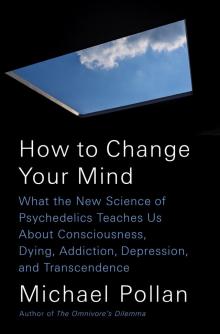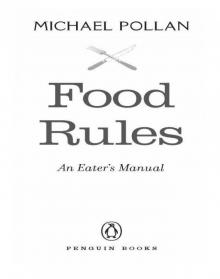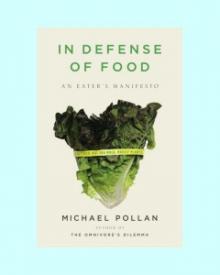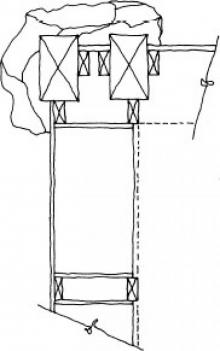- Home
- Michael Pollan
In Defense of Food Page 6
In Defense of Food Read online
Page 6
SEVEN - BEYOND THE PLEASURE PRINCIPLE
W e eaters, alas, don’t reap nearly as much benefit from nutritionism as food producers. Beyond providing a license to eat more of the latest approved foodlike substance, which we surely do appreciate, nutritionism tends to foster a great deal of anxiety around the experience of shopping for food and eating it. To do it right, you’ve got to be up on the latest scientific research, study ever-longer and more confusing ingredients labels,* sift through increasingly dubious health claims, and then attempt to enjoy foods that have been engineered with many other objectives in view than simply tasting good. To think of some of the most delicious components of food as toxins, as nutritionism has taught us to do in the case of fat, does little for our happiness as eaters. Americans have embraced a “nutritional philosophy,” to borrow Jane Brody’s words, that, regardless of whether that philosophy does anything for our health, surely takes much of the pleasure out of eating.
But why do we even need a nutritional philosophy in the first place? Perhaps because we Americans have always had a problem taking pleasure in eating. We certainly have gone to unusual lengths to avoid it. Harvey Levenstein, who has written two illuminating histories of American food culture, suggests that the sheer abundance of food in America has bred “a vague indifference to food, manifested in a tendency to eat and run, rather than to dine and savor.” To savor food, to conceive of a meal as an aesthetic experience, has been regarded as evidence of effeteness, a form of foreign foppery. (Few things have been more likely to get an American political candidate in hot water than a taste for fine food, as Martin Van Buren discovered during his failed 1840 reelection campaign. Van Buren had brought a French chef to the White House, a blunder seized on by his opponent, William Henry Harrison, who made much of the fact that he subsisted on “raw beef and salt.” George H. W. Bush’s predilection for pork rinds and Bill Clinton’s for Big Macs were politically astute tastes to show off.)
It could well be that, as Levenstein contends, the sheer abundance of food in America has fostered a culture of careless, perfunctory eating. But our Puritan roots also impeded a sensual or aesthetic enjoyment of food. Like sex, the need to eat links us to the animals, and historically a great deal of Protestant energy has gone into helping us keep all such animal appetites under strict control. To the Christian social reformers of the nineteenth century, “The naked act of eating was little more than unavoidable…and was not to be considered a pleasure except with great discretion.” I’m quoting from Laura Shapiro’s Perfection Salad, which recounts the campaign of these domestic reformers to convince Americans, in the words of one, “that eating is something more than animal indulgence, and that cooking has a nobler purpose than the gratification of appetite and the sense of taste.” And what might that nobler purpose be? Sound nutrition and good sanitation. By elevating those scientific principles and “disdaining the proof of the palate,” Shapiro writes, “they made it possible for American cooking to accept a flood of damaging innovations for years to come”-low-fat processed food products prominent among them.
So scientific eating is an old and venerable tradition in America. Here’s how Harvey Levenstein sums up the quasiscientific beliefs that have shaped American attitudes toward food for more than a century: “that taste is not a true guide to what should be eaten; that one should not simply eat what one enjoys; that the important components of foods cannot be seen or tasted, but are discernible only in scientific laboratories; and that experimental science has produced rules of nutrition which will prevent illness and encourage longevity.” Levenstein could be describing the main tenets of nutritionism.
Perhaps the most notorious flowering of pseudoscientific eating (and protonutritionism) came in the early years of the twentieth century, when John Harvey Kellogg and Horace Fletcher persuaded thousands of Americans to trade all pleasure in eating for health-promoting dietary regimens of truly breathtaking rigor and perversity. The two diet gurus were united in their contempt for animal protein, the consumption of which Dr. Kellogg, a Seventh-Day Adventist who bore a striking resemblance to KFC’s Colonel Sanders, firmly believed promoted both masturbation and the proliferation of toxic bacteria in the colon. During this, the first golden age of American food faddism, protein performed much the same role that fat would perform during the next. At Kellogg’s Battle Creek sanitarium, patients (who included John D. Rockefeller and Theodore Roosevelt) paid a small fortune to be subjected to such “scientific” practices as hourly yogurt enemas (to undo the damage that protein supposedly wreaked on the colon); electrical stimulation and “massive vibration” of the abdomen; diets consisting of nothing but grapes (ten to fourteen pounds of them a day); and at every meal, “Fletcherizing,” the practice of chewing each bite of food approximately one hundred times. (Often to the rousing accompaniment of special chewing songs.) The theory was that thorough mastication would reduce protein intake (this seems certain) and thereby improve “subjective and objective well-being.” Horace Fletcher (aka “the great masticator”) had no scientific credentials whatsoever, but the example of his own extraordinary fitness-at fifty he could bound up and down the Washington Monument’s 898 steps without pausing to catch his breath-while existing on a daily regimen of only 45 well-chewed grams of protein was all the proof his adherents needed.* The brothers Henry and William James both became enthusiastic “chewers.”†
Whatever their biological efficacy, all these dietary exertions had the effect of removing eating from social life and pleasure from eating; compulsive chewing (much less hourly enema breaks) is not exactly conducive to the pleasures of the table. Also, Fletcherizing would have forcibly drained food of the very last glimmer of flavor long before the hundredth contraction of the jaw had been counted. Kellogg himself was outspoken in his hostility to the pleasures of eating: “The decline of a nation commences when gourmandizing begins.”
If that is so, America had little reason to worry.
America’s early attraction to various forms of scientific eating may also have reflected discomfort about the way other people eat: the weird, messy, smelly, and mixed-up eating habits of immigrants.‡ How a people eats is one of the most powerful ways they have to express, and preserve, their cultural identity, which is exactly what you don’t want in a society dedicated to the ideal of “Americanization.” To make food choices mo�
�re scientific is to empty them of their ethnic content and history; in theory, at least, nutritionism proposes a neutral, modernist, forward-looking, and potentially unifying answer to the question of what it might mean to eat like an American. It is also a way to moralize about other people’s choices without seeming to. In this, nutritionism is a little like the institution of the American front lawn, an unobjectionable, if bland, way to pave over our differences and Americanize the landscape. Of course in both cases unity comes at the price of aesthetic diversity and sensory pleasure. Which may be precisely the point.
EIGHT - THE PROOF IN THE LOW-FAT PUDDING
W hatever the sacrifice of pleasure, it would be made up for by better health-that, at least, has always been nutritionism’s promise. But it’s difficult to conclude that scientific eating has contributed to our health. As mentioned, the low-fat campaign coincided with a dramatic increase in the incidence of obesity and diabetes in America. You could blame this unfortunate fallout on us eaters for following the official advice to eat more low-fat food a little too avidly. This explanation suggests that the problem with the low-fat campaign has been in its execution rather than in the theory behind it, and that a better, clearer public health message might have saved us from ourselves. But it is also possible that the advice itself, to replace fats in the diet with carbohydrates, was misguided. As the Hu paper suggests, there is a growing body of evidence that shifting from fats to carbohydrates may lead to weight gain (as well as a host of other problems). This is counterintuitive, because fats contain nearly twice as many calories as carbs (9 per gram for fats as compared to 5 for either carbohydrates or protein). The theory is that refined carbohydrates interfere with insulin metabolism in ways that increase hunger and promote overeating and fat storage in the body. (Call it the carbohydrate hypothesis; it’s coming.)* If this is true, then there is no escaping the conclusion that the dietary advice enshrined not only in the McGovern “Goals” but also in the National Academy of Sciences report, the dietary guidelines of the American Heart Association and the American Cancer Society and the U.S. food pyramid bears direct responsibility for creating the public health crisis that now confronts us.
Even if we accept the epidemic of obesity and diabetes as the unintended consequence of the war against dietary fat-collateral damage, you might say-what about the intended consequence of that campaign: the reduction of heart disease? Here is where the low-fat campaigners have chosen to make their last stand, pointing proudly to the fact that after peaking in the late sixties, deaths from heart disease fell dramatically in America, a 50 percent decline since 1969. Cholesterol levels have also fallen. Epidemiologist Walter C. Willett of the Harvard School of Public Health (a coauthor of the Hu paper) cites the increase in consumption of polyunsaturated fats “as a major factor, if not the most important factor, in the decline in heart disease” observed in the seventies and eighties and calls the campaign to replace saturated fats in the diet one of the great public health success stories of our time. And so it would appear to be: We reduced our saturated fat intake, our cholesterol levels fell, and many fewer people dropped dead of heart attacks.
Whether the low-fat campaigners should take the credit for this achievement is doubtful, however. Reducing mortality from heart disease is not the same thing as reducing the incidence of heart disease, and there’s reason to question whether underlying rates of heart disease have greatly changed in the last thirty years, as they should have if changes in diet were so important. A ten-year study of heart disease mortality published in the New England Journal of Medicine in 1998 strongly suggests that most of the decline in deaths from heart disease is due not to changes in lifestyle, such as diet, but to improvements in medical care. (Though cessation of smoking has been important.) For while during the period under analysis, heart attack deaths declined substantially, hospital admissions for heart attack did not. Modern medicine is clearly saving more people suffering from heart disease, but it appears that we haven’t had nearly as much success eliminating the disease itself.
NINE - BAD SCIENCE
T o understand how nutrition science could have been so spectacularly wrong about dietary fat and health, it’s important to understand that doing nutrition science isn’t easy. In fact, it’s a lot harder than most of the scientists who do it for a living realize or at least are willing to admit. For one thing, the scientific tools at their disposal are in many ways ill suited to the task of understanding systems as complex as food and diet. The assumptions of nutritionism-such as the idea that a food is not a system but rather the sum of its nutrient parts-pose another set of problems. We like to think of scientists as being free from ideological taint, but of course they are as much the product of their ideological environment as the rest of us. In the same way nutritionism can lead to a false consciousness in the mind of the eater, it can just as easily mislead the scientist.
The problem starts with the nutrient. Most nutritional science involves studying one nutrient at a time, a seemingly unavoidable approach that even nutritionists who do it will tell you is deeply flawed. “The problem with nutrient-by-nutrient nutrition science,” points out Marion Nestle, a New York University nutritionist, “is that it takes the nutrient out of the context of the food, the food out of the context of the diet, and the diet out of the context of the lifestyle.”
If nutrition scientists know this, why do they do it anyway? Because a nutrient bias is built into the way science is done. Scientists study variables they can isolate; if they can’t isolate a variable, they won’t be able to tell whether its presence or absence is meaningful. Yet even the simplest food is a hopelessly complicated thing to analyze, a virtual wilderness of chemical compounds, many of which exist in intricate and dynamic relation to one another, and all of which together are in the process of changing from one state to another. So if you’re a nutrition scientist you do the only thing you can do, given the tools at your disposal: Break the thing down into its component parts and study those one by one, even if that means ignoring subtle interactions and contexts and the fact that the whole may well be more than, or maybe just different from, the sum of its parts. This is what we mean by reductionist science.
Scientific reductionism is an undeniably powerful tool, but it can mislead us too, especially when applied to something as complex, on the one side, as a food and on the other a human eater. It encourages us to take a simple mechanistic view of that
transaction: Put in this nutrient, get out that physiological result. Yet people differ in important ways. We all know that lucky soul who can eat prodigious quantities of fattening food without ever gaining weight. Some populations can metabolize sugars better than others. Depending on your evolutionary heritage, you may or may not be able to digest the lactose in milk. Depending on your genetic makeup, reducing the saturated fat in your diet may or may not move your cholesterol numbers. The specific ecology of your intestines helps determine how efficiently you digest what you eat, so that the same 100 calories of food may yield more or less food energy depending on the proportion of Firmicutes and Bacteroides resident in your gut. In turn, that balance of bacterial species could owe to your genes or to something in your environment. So there is nothing very machinelike about the human eater, and to think of food as simply fuel is to completely misconstrue it. It’s worth keeping in mind too that, curiously, the human digestive tract has roughly as many neurons as the spinal column. We don’t yet know exactly what they’re up to, but their existence suggests that much more is going on in digestion than simply the breakdown of foods into chemicals.
Also, people don’t eat nutrients; they eat foods, and foods can behave very differently from the nutrients they contain. Based on epidemiological comparisons of different populations, researchers have long believed that a diet containing lots of fruits and vegetables confers some protection against cancer. So naturally they ask, What nutrient in those plant foods is responsible for that effect? One hypothesis is that the antioxidants in fresh produce-compounds like beta-carotene, lycopene, vitamin E, and so on-are the X factor. It makes good theoretical sense: These molecules (which plants produce to protect themselves from the highly reactive forms of oxygen they produce during photosynthesis) soak up the free radicals in our bodies, which can damage DNA and initiate cancers. At least that’s how it seems to work in a test tube. Yet as soon as you remove these crucial molecules from the context of the whole foods they’re found in, as we’ve done in creating antioxidant supplements, they don’t seem to work at all. Indeed, in the case of beta-carotene ingested as a supplement, one study has suggested that in some people it may actually increase the risk of certain cancers. Big oops.

 A Place of My Own: The Education of an Amateur Builder
A Place of My Own: The Education of an Amateur Builder Cooked: A Natural History of Transformation
Cooked: A Natural History of Transformation The Omnivore's Dilemma
The Omnivore's Dilemma How to Change Your Mind
How to Change Your Mind Food Rules
Food Rules In Defense of Food
In Defense of Food A Place of My Own
A Place of My Own